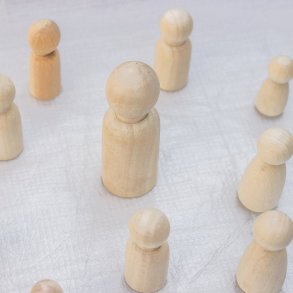By Ted Rau and originally published as a single article at sociocracyforall
This is the first part of a 3 part article – looking at the first tool. Part 2 is here. Part 3 is here.
Many organizations are intrigued by the idea of self-management using circle-based frameworks and other decision making tools from sociocracy. However, it can be intimidating to implement those methods. You’ll have to do research, train everyone, implement — months or even years of transition time. And regular work needs to get done as well! I always compare changes in governance to beating heart surgery. Tricky — at the very least.
Is there an easier way? Most of all, is there a safer way? Something that’s not all-or-nothing but more step-by-step? Luckily, sociocracy lends itself to that. Start with something and then add more features if and when you want. You do not have to ask anyone for permission. You have full power over your self-management method.
The 3 tools presented here don’t need long explanations or trainings. You can do a small-scale experiment and evaluate how it went. When you’re ready to hear more beyond those three tools, I am happy to point you to the next step.
I picked these three tools because, in our experience, these are the tools that our training participants bring into their companies and that stick the most. Try them and see what you think.
Using rounds in meetings
Rounds are the most contagious tools from sociocracy for improving the decision making. The basic idea is ridiculously simple: everyone gets a turn to speak, one by one. Yes, that’s it. (I promised easy, right?)
How to use rounds
 The easiest way is to do rounds is to sit in a circle and follow a natural order by where people sit. When I see that the person next to me is speaking, I know I will have my turn next. That also helps people to mentally prepare for their turn. In online-meetings, we encourage facilitators to call on two people at a time so the second one can get ready. (Which also means they will have their contribution somewhat pre-sorted!)
The easiest way is to do rounds is to sit in a circle and follow a natural order by where people sit. When I see that the person next to me is speaking, I know I will have my turn next. That also helps people to mentally prepare for their turn. In online-meetings, we encourage facilitators to call on two people at a time so the second one can get ready. (Which also means they will have their contribution somewhat pre-sorted!)
Obviously, it helps to have a facilitator to do rounds. We also do not recommend doing rounds in a group bigger than 8 or 9 people. (If your group is larger, continue reading to tool #3.)
Benefits of using rounds
Rounds have benefits for both sides, speakers and listeners. Let’s look at the speaker first. What is inherent in rounds is that everyone’s voice matters. Equally. What I say matters as much as what my co-worker says. And what my co-worker says matters as much as what I say. One might have more insight on a given topic than the other but good thoughts sometimes come from unexpected places.

Rounds change the rules of the game so it doesn’t become a game of convincing each other. Instead, it becomes a game of sharing your thoughts and co-creation. It sometimes feels like we’re all giving our offering and put it in the middle of the circle where it can grow into something bigger and better than I could have come up with. When I am speaking I know I am protected from people wanting to prove me wrong. Rounds carve out a safe space to share.
What are rounds like for listeners? One benefit for listeners is that when I know it is not my turn and I know it will take another two or three turns until I can speak, I start to relax. I sit back and listen because there is nothing else to do. I can focus on the speaker, trying to understand what the issue on the table looks like from their view.
Rounds make it manifest that our views might be different. Beyond finding the absolute truth or pushing my own agenda, we honor the variety of experiences. All of a sudden there is space. And once there is space, solutions are more likely to emerge.
Typical reservations about using rounds
Are rounds artificial?
Maybe. After seeing how easily my children picked up rounds, I have given up on finding out what is artificial or natural. I find something else more important. Talking without order means you will be in “natural” flow of conversation. In Sociocracy For All, we call this debate style. Debate style: you say something and I will try and prove you wrong because my idea is better. Debate style brings along all the implicit and mostly unquestioned power dynamics, men speaking more often than women and so on. That means that deciding to not use rounds means making a choice, and it is a choice that has known, measurable disadvantages.
Are rounds hard?
Are rounds hard? Yes and no. In the beginning, rounds are hard for some people. Yes, changing your patterns is hard. But they are not complicated. Whenever I attend a (non-sociocratic) meeting where people talk over each other, I silently enjoy noticing how startled I am when I witness that.
 Of course I myself am ego-driven and I have a ton of good ideas! But I also know that it only takes one person in the circle engaging in cross-talk and the good effects of rounds are lost. What do I do with all my brilliant ideas? I write them on a piece of paper. When it is my turn, I will often look at my piece of paper and realize that, after a few minutes of listening to others, about 90% of my ideas have either been named or, on second thought, they don’t seem all that great or urgent anymore.
Of course I myself am ego-driven and I have a ton of good ideas! But I also know that it only takes one person in the circle engaging in cross-talk and the good effects of rounds are lost. What do I do with all my brilliant ideas? I write them on a piece of paper. When it is my turn, I will often look at my piece of paper and realize that, after a few minutes of listening to others, about 90% of my ideas have either been named or, on second thought, they don’t seem all that great or urgent anymore.
Humbled, I am often grateful for having been forced to weed through what I say. And when people pass on their turn saying “All I wanted to say has been said” I feel the urge to get up and hug them in gratitude for not putting the group through endless repetitions. Which also answers the last reservation I hear very often: aren’t rounds lengthy? Maybe. But inconsiderate decisions, repetitive statements and emotional “clean-up” after disregard of team members take a lot of time too. Your choice?
Magic phrases to start using rounds
Next time you find yourself in a debate style discussion, try one of these two sentences:
- “I would really be interested to hear what everyone in the room thinks about this. Can we do a go-around and everyone shares, and we try to give not to interrupt each other?”
- “I notice how I want to say something but I don’t want to over-talk anyone else. Could we slow this down and talk one by one in a round so we all get to speak without having to compete?
Part 2 of this 3-part article is here. Part 3 is here.
Republished with permission.
Featured Image added by Enlivening Edge Magazine. Image by Gerd Altmann from Pixabay




